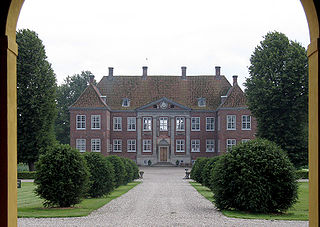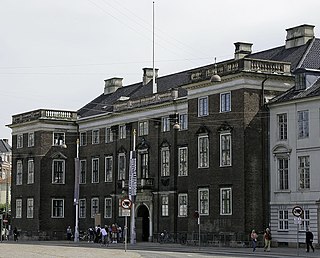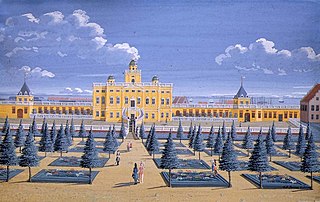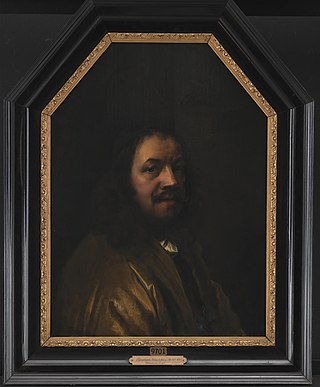Contents
| |||||
| Decades: | |||||
|---|---|---|---|---|---|
| See also: | Other events of 1673 List of years in Denmark | ||||
Events from the year 1673 in Denmark .
| |||||
| Decades: | |||||
|---|---|---|---|---|---|
| See also: | Other events of 1673 List of years in Denmark | ||||
Events from the year 1673 in Denmark .

Amalienborg is the official residence for the Danish royal family and is located in Copenhagen. Frederick VIII's palace complex has four identical Classical façades, effectively four palaces, with Rococo interiors, laid around an octagonal courtyard. At the centre is a large equestrian statue of Frederick V. Amalienborg was originally built for four noble families, but after Christiansborg Palace burned in 1794 the royal family bought the palaces and moved in. Over the years various monarchs and their families have lived there, including today's King Frederik X and Queen Mary.

Princess Louise Charlotte of Denmark was a Danish princess, and a princess of Hesse-Kassel by marriage to Prince William of Hesse-Kassel.

The architecture of Denmark has its origins in the Viking Age, richly revealed by archaeological finds. It became firmly established in the Middle Ages when first Romanesque, then Gothic churches and cathedrals sprang up throughout the country. It was during this period that, in a country with little access to stone, brick became the construction material of choice, not just for churches but also for fortifications and castles.

Nysø Manor, located near Præstø in the southeast of the Danish island of Sealand, was built in 1673 for Jens Lauridsen, a local functionary. It now houses the Thorvaldsen Collection, a group of works by the Danish sculptor Bertel Thorvaldsen, who lived and worked there in his later years.

Ewert Janssen or Evert Janssen was a Danish architect who became a royal masterbuilder in 1668. His greatest achievement was Charlottenborg Palace in Copenhagen.

Sophie Amalienborg was a pleasure palace roughly located where Amalienborg stands today in Copenhagen, Denmark. It was built by Queen Consort Sophie Amalie who lived there until her death in 1685 after her husband, King Frederick III, died a few years prior to its completion.
Dronningens Enghave was a seventeenth-century royal pleasure garden located just outside the Western City Gate of Copenhagen, Denmark, roughly where Tivoli Gardens and Copenhagen Central Station lies today.

Abraham Wuchters was a Brabant-born Dutch-Danish painter and engraver. He was born in Antwerp but had most of his career in Denmark where he and Karel van Mander III became the preferred painters of the Danish King, nobility and bourgeoisie. Together they represent the main influence from the Dutch Golden Age on Danish Baroque art.

The Odd Fellows Mansion is a Rococo town mansion in Copenhagen, Denmark, named after the local branch of the Independent Order of Odd Fellows which acquired the building in 1900. Before that, it was known as the Berckentin and later the Schimmelmann Mansion after its successive owners.

Jægerspris Castle, in Jægerspris on the Hornsherred peninsula west of Copenhagen, is a Danish manor house. It has belonged to the Danish monarchs for most of its history which dates back to the 13th century. In the 1850s it became a retreat for King Frederik VII and his morganatic wife Countess Danner, who sought refuge there to escape the controversy their marriage had caused among the establishment in Copenhagen. After the king's death, Countess Danner turned it into an asylum for women.
Events from the year 1730 in Denmark.
Events from the year 1671 in Denmark.
Events from the year 1689 in Denmark.

Garnison Church, Copenhagen

Moesgård is a former manor house and a listed building in Aarhus Municipality. The current buildings were completed in 1778 and was listed in the Danish registry of protected buildings and places by the Danish Heritage Agency on 17 July 1918.
Christinelund, originally a farm under Nysø Manor, is located a few kilometres east of central Præstø, on the island of Zealand's Jungshoved peninsula, in Vordingborg Municipality in southeastern Denmark. It takes its name from the salonist Christine Stampe and was frequently visited by Hans Christian Andersen in the 1850s, when it was the home of Henrik and Jonna Stampe. The current main building was completed in 1860 to a design by the architect Ferdinand Meldahl. It was listed on the Danish registry of protected buildings and places by the Danish Heritage Agency on 23 February 1978. The property is now operated as a bed and breakfast.

Christine Stampe, née Dalgas, was a Danish noblewoman known as one of the chief benefactors of the Danish/Icelandic sculptor Bertel Thorvaldsen.

Count Frederik of Ahlefeldt-Rixingen was a Danish landowner and statesman. By birth member of the House of Ahlefeldt, he was the first reigning Count of Rixingen. He was also Grand Chancellor during the reign of King Christian V. He was also Landgrave of Langeland.
Snertingegård, also known simply as Snertinge, is a manor house and estate located just north of Vordingborg, in southeastern Denmark. It was one of 12 manors established after Vordingborg Cavalry District was dissolved in 1884. The Renaissance Revival style main building and home farm were built for Defence Minister Christian Frederik Hansen in 1857 from designs by Ferdinand Meldahl. Both buildings were listed on the Danish registry of protected buildings and places in 1978.